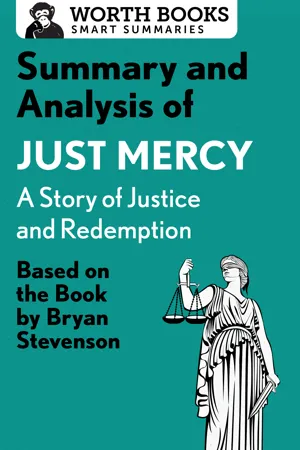Summary
Introduction: Higher Ground
In 1983, while interning for the Southern Prisoners Defense Committee (SPDC), a legal aid nonprofit based in Atlanta, Stevenson meets, for the first time, someone on death row. Henry has been housed in the maximum-security Georgia Diagnostic and Classification Center for two years, despite having no access to a lawyer.
The meeting is awkward and intense—and has lasting effects for the young law student. Stevenson, all of 23 years old, is on break from Harvard Law School, where he felt disconnected and put off by the abstract nature of his studies. His task now is far from abstract: He has been sent to inform Henry that the SPDC is looking into his case, and—more importantly—that no execution date will be scheduled during the next year.
An openly hostile guard escorts Stevenson to the visitation room, where, filled with panic about meeting a condemned prisoner, he awaits Henry, who is brought into the room in shackles and handcuffs. After he is unchained, Stevenson greets him with a stammering apology. He is put at ease by the prisoner, who is grateful for SPDC’s intervention. Eventually, the two begin to speak about normal things like music and family, turning away from the case to ordinary conversation for three hours.
Like Stevenson, Henry is 23 and black. To the young lawyer, he looks just like any other peer—a regular person rather than a frightening criminal. He also, for Stevenson, personifies the injustice of the American criminal justice system. In the span of that short meeting, Stevenson is put on the path that leads to his career fighting for the unjustly accused and incarcerated.
This fight will be deeply connected to Stevenson’s own history. Born and raised in a racially segregated town in coastal Delaware, Stevenson grew up in a town where black people “worked hard all the time but never seemed to prosper.” Using his own experiences, and the even more traumatic experiences of his parents and grandparents, he draws a line from America’s history of oppressive racism to the current era of mass incarceration.
In its current form, he says, the criminal justice system has created far more problems than it has addressed. He enumerates its many disastrous policies: the abolition of parole in many states; “three strikes” laws that send nonviolent offenders to prison for decades; child offenders charged as adults; drug addicts prosecuted as criminals; and the great number of poor people—many of them black—tried and convicted without decent counsel.
Federal and state governments now dole out approximately $80 billion a year to build and maintain jails and prisons. Stevenson looks at the US justice system and sees a colossal waste of human, financial, and spiritual resources. “The true measure of our character is how we treat the poor, the disfavored, the accused, the incarcerated, and the condemned,” he writes. This humane reflection sums up Stevenson’s philosophy, and explains what motivates tireless work.
Chapter One: Mockingbird Players
Walter McMillian is a black Alabama man convicted of murder and on death row. His particular case made national news, and Bryan Stevenson’s work on McMillian’s behalf garnered widespread attention for himself and for his organization, the Equal Justice Initiative (EJI).
During his fourth year at the SPDC, where he had returned to work after graduation, Stevenson and a legal aid colleague working in Alabama secured federal funding to represent people on death row, many of whom had no legal representation at all. By this point, the young lawyer had achieved many victories, including stays of execution for a number of men, some only minutes away from being electrocuted. At their meeting on Alabama’s death row, Stevenson is struck by McMillian’s emotional insistence on his innocence. Still, overworked and overwhelmed, Stevenson tries to keep his client’s expectations realistic.
A few weeks after he meets with McMillian, Stevenson receives a phone call at his office from Robert E. Lee Key, the judge who had presided over McMillian’s trial. He tries to warn Stevenson off the case by asserting, alternately, that McMillian was a drug lord and possible member of the “Dixie Mafia”; that he couldn’t appoint a lawyer to represent McMillian who wasn’t a member of the Alabama bar (Stevenson was); and that McMillian wasn’t actually indigent because he had drug money stashed all over Monroe County. All of the judge’s objections were false or hollow, and Stevenson had agreed to serve as McMillian’s lawyer voluntarily—he wasn’t seeking official appointment. But this disingenuous exchange provided an illuminating (and depressing) glimpse at the massive resistance Stevenson would encounter during his work with McMillian, and throughout his career.
The hostility Stevenson faced was a function of two things: The woman McMillian was accused of murdering was white, and his past relationship with a married white woman, Karen Kelly, was looked on by the white community with hostility. Born outside Monroeville, Alabama—ironically, the setting of the classic novel on miscegenation, racism, and our legal system, To Kill a Mockingbird—McMillian was a successful businessman in a town where that alone was suspicious. In 1986, while he was in a relationship with Kelly, hostility towards interracial relationships was so great it was still outlawed in the state’s constitution.
This hostility was central to McMillian’s eventual conviction for the murder of Ronda Morrison, a white 18-year-old college student found dead at the cleaning business where she worked. ...
